[Color Computer, Ark Royal Games]

The Guadalcanal campaign is WWII’s ultimate ‘variety show’, showcasing the war’s most iconic memorial anchors: Aircraft carriers! Naval landings! Jungle warfare! Submarines! Air Combat! Tanks! Commandos! Honestly, the only things lacking are trains and Finnish ski troops. Yet, out of the six (!) games I have played so far on the Guadalcanal campaign (or part of it), none cover the land operation. This is fixed today by Ark Royal’s Guadalcanal.
I had been mildly impressed by Ark Royal’s first game, Across the Rubicon, which exceeded my expectations for the first game of a totally forgotten solo designer developing exclusively on Color Computer, a platform infamous for its lacklustre games. Alas, later Ark Royal games did not confirm this initial first impression. On the other hand, I had played the second edition of Across the Rubicon (aka Rubicon II), released in December 1983, and that edition had massively overhauled the initial Across the Rubicon which I considered nigh-unplayable, so I don’t know what to expect. I know what not to expect: good graphics!
The naval assault (turns 1 – 5)
The objective in Guadalcanal is to locate and destroy the 8 Japanese “camps” (effectively supply depots) hidden in the jungle. My force is composed of 13 Marine combat units (maximum strength: 20), 3 Marine engineers (aka “Seabees“, maximum strength: 4 for now) and some limited naval support. That looks like a lot, but it will be needed because there is a lot of jungle to comb through, thanks to the new (for Ark Royal games) smooth-ish scroll feature – the map is one screen wide but three-and-half screens high.
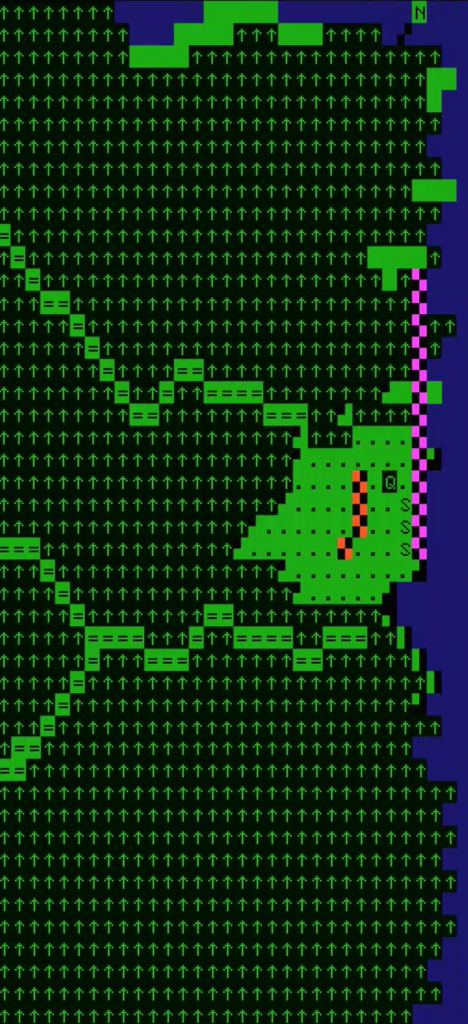
I have a lot of options to help with my search, but the best one will be air support: the Japanese have started to build an airfield on the island, and the Seabees will finish it. But first, I need to clear the Japanese defenders. I want to get my air force operational as soon as possible, so I spend my two naval supports to remove them:
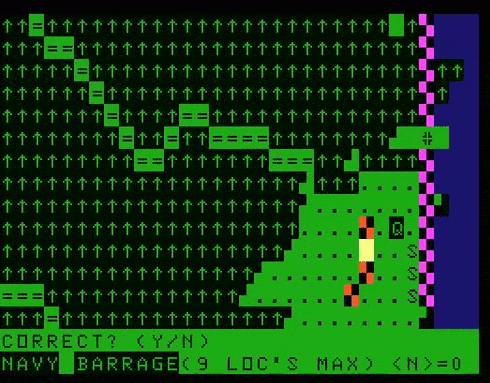
The ships remove one of the enemy units and badly damage the other, and my Marines rush and wipe out what is left. My Seabees rush to finish the airport. Meanwhile, my Marines in the North (which should be the West historically, but whatever) encounter a large Japanese force in the jungle that stops them immediately, and the Japanese rush from the South to investigate the commotion – in Guadalcanal, the Japanese may move their units between each of the player’s movements – sometimes several units in a row.

At the end of the turn, Japanese bombers try an attack run on the airfield, but the bombs narrowly miss the targets of value:

That was an intense first turn! Time for a recap:

Some air ops start to be available because I control a 50%-built airfield, but not many. I have 54 replacements possible, having so far received 10 strength points in casualty (Japanese: 50). With the exception of the air ops pool which is renewed every turn, I will have to do with that until the next supply run which should arrive turn 5 – but it can be delayed by enemy air activity.
The following turns are spent enlarging the perimeters and failing to bring back my Marines stuck in skirmishes against the Japanese in the North – it is not yet the time to go on the offensive.

I don’t use my air operations, which converts them into Combat Air Patrols at the end of the turn and decreases the chance of bombing runs. It does not work very well – the Japanese try two more bombing runs, but that does not change anything as they don’t hit anything again. I finally finish the airfield turn 4: the Cactus Air Force is finally operational.
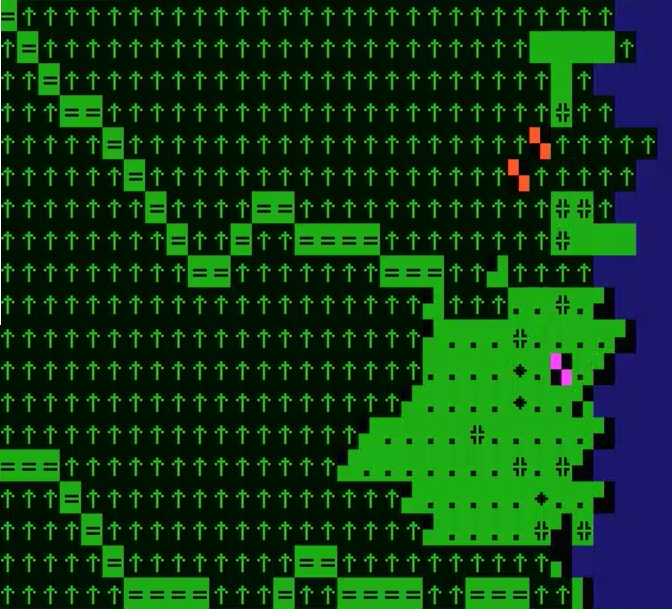
This is just in time to receive the supplies turn 5:
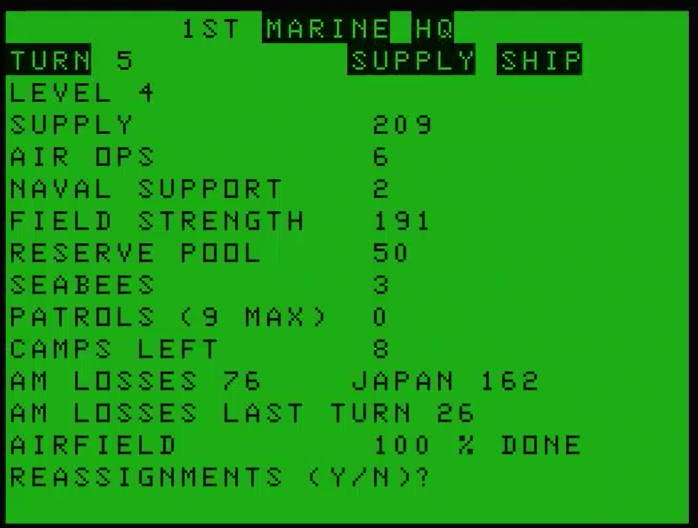
I receive new supplies that I do not need yet, 2 more naval support and around 40 strength points in reserve, which is just as well because I had been badly drained by combat.
Having completed the airfield also pushes my air ops to 6 every turn, so I have something to work with until the next supply run, scheduled for turn 12.
First raids (turns 5 – 12)
Now that I have my airfield and a solid situation in the South, it is time to do what I came here for: Search & Destroy!
I spend one of my air ops for an “air search” in the South – I have been attacked non-stop from there so I suspect the Japanese have a supply depot nearby. I find it on my first try:

With some more search missions, I find another supply depot North and a last one far in the West – for the latter the approximate location had been revealed by asking one of my units to check Intelligence. I also learn that the Japanese have around 45 units in total.
I push a small force of full-strength Marines to the North, and try to also push my way with my Northern units toward the Northern depot. Both groups are supported by the Seabees, who are now tasked with clearing the jungle. This is important: cleared jungle is replaced by what the game calls the “camp” terrain (the one with the dots), which has many advantages:
- It is cheap to move in as it costs 1 movement point per tile, against a random 1-3 for Jungle. For reference, Marines have 6 movement points every turn,
- It is the only terrain in which Marines can be reinforced by strength points coming from the reserve,
- It automatically reveals Japanese units located in it, unlike Jungle in which Japanese units are invisible until contact.

I easily reach and destroy the Southern depot, but my units in the North have been fighting since the beginning of the game and never received replacements. Once my naval support credits are spent, I have to allocate air missions to ground support. It gives the Japanese another opportunity for a bombing run, and this time it damages my airfield and hits one of my units.
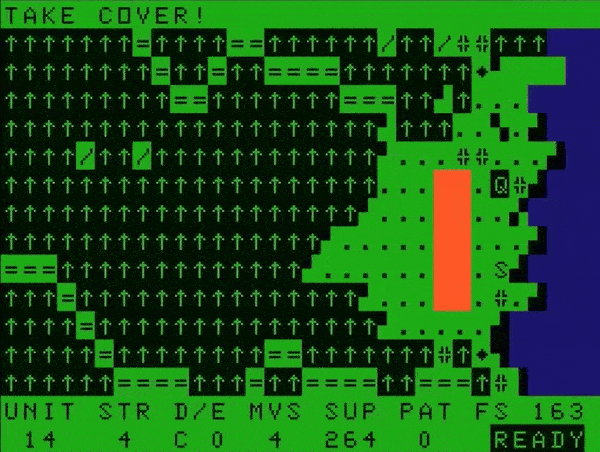
Back to square one: I must repair the airport and fight with only a handful of air missions. I still push through and manage to reach the Northern Japanese depot, but a lot of my units are at half-strength and I don’t have any replacements left.

There isn’t much happening between turns 10 and 12 – I simply fall back to my camp while waiting for more reinforcements – so it is a good time to talk about what I learned fighting the Japanese in the North. From what I understand of the game, the Japanese never receive new units. Instead, they (often) try to preserve their depleted units by retreating to the camp to refill them, exactly like I do, and just like me they appear to receive new reserves only occasionally.
Destroying Japanese units before they can retreat is harder than I expected. In Guadalcanal, you can only engage one unit by movement, and that unit is more often than not the strongest eligible – most of the time when I try to pursue a weakened Japanese unit I end up attacking a well-rested one, something that quickly drained my reserves as defenders have a significant combat bonus. It also leaves me vulnerable and unable to pursue further, as combats end movement for the turn. Except at the very beginning of the game, I mostly destroyed Japanese units that attacked even though they were already badly mauled, or infiltrators that made it a bit too far into my lines.

“Japanese Attacking Camp!” is just a message informing me that a Japanese unit moved into “camp” terrain.
Hanging by a thread (turn 13-19)
I receive new supplies turn 13 (it was delayed one turn because I let the Japanese control the air turn 12), and it is disappointing: 25 replacements, when I needed 5 times that.

Due to the limited replacement available, I reinforce only 2 or 3 units for an expedition for the Western depot, which also immediately becomes an expedition for the Western depots, as my planes find a second one:
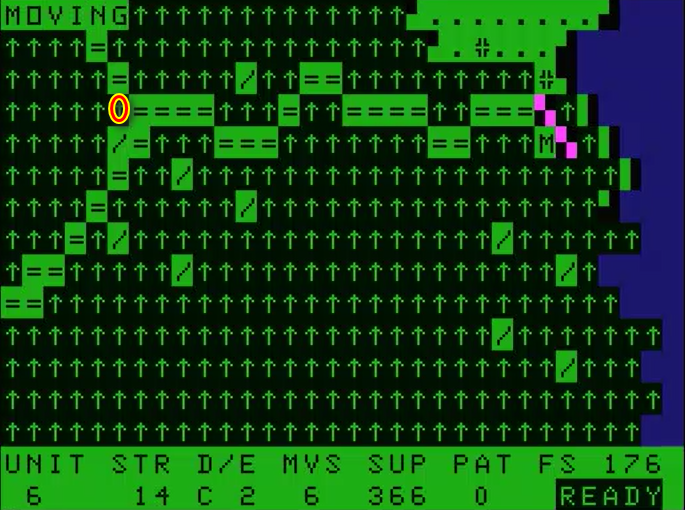
The expedition to the West never enters the jungle, as I am almost immediately attacked from all directions. The game tracks the combat experience of my units, but I allocated almost all my replacements to my spearhead which is composed of my most veteran units. Said otherwise, my defenders are green and/or half-strength. I lose some Seabees and one of my Marine units, and most of the other defenders fall below 5 in strength points. I use all the tricks to survive those horrible turns, including turning some units into “patrols”, which reallocate half of their strength to the reserve pool for immediate redeployment. I also spam mortars – they are supply-intensive and inaccurate, but at range 2 they are safe to blunt the Japanese assault:

The “dash” from my latest air search disappeared, but that’s a bug mentioned in the manual.
The Japanese assault finally abates just as new supplies arrive turn 20. Turn 20 is important: every 20 turns, all Seabees are replaced and gain 1 in max strength (the lost combat unit will never come back). Additionally, I permanently receive +1 air ops every turn. But what’s most important to me at that moment is my reserve pool. How many did I receive?
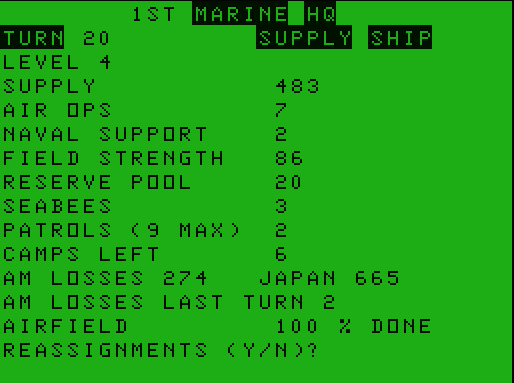
… only 20, when my total strength has fallen to 86. It is not looking good.

Lightweight offensive (turn 20-24)
I don’t have much, but I can’t cower forever. I convert the defenders that earned the least experience into more patrols, and I recreate a curtain of veteran defenders of strength 10-12 – I don’t feel I need as many defenders as before as my Seabees significantly cleared the jungle, so I can see the Japanese coming.
Meanwhile, I replace one of the two units in my spearhead to a whopping 15 strength and I advance slowly, using my air force to detect and safely destroy the Japanese with as little combat as I can.

I barely advance, but “barely” is better than nothing. I receive very few defensive losses, mostly because the Japanese did not aggressively push – presumably they have the same kind of reserve issues as I have. They seem to attack more aggressively at the end of turn 24…
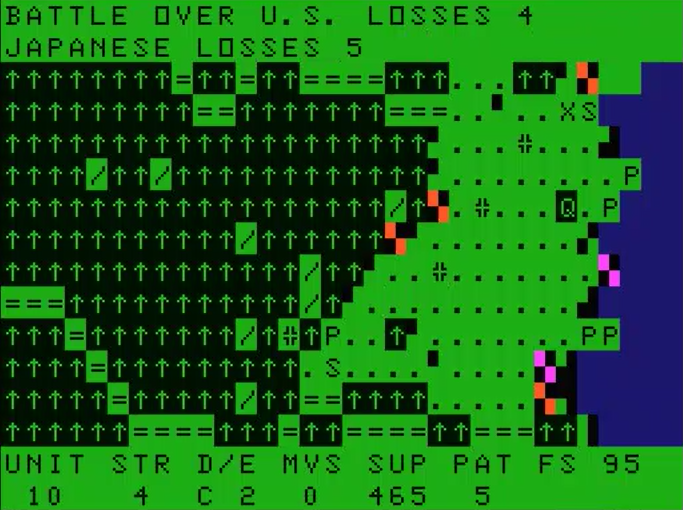
… but I don’t care because a new supply ship arrives, and I finally have something to work with: 57 replacements! Winter The monsoon is over.
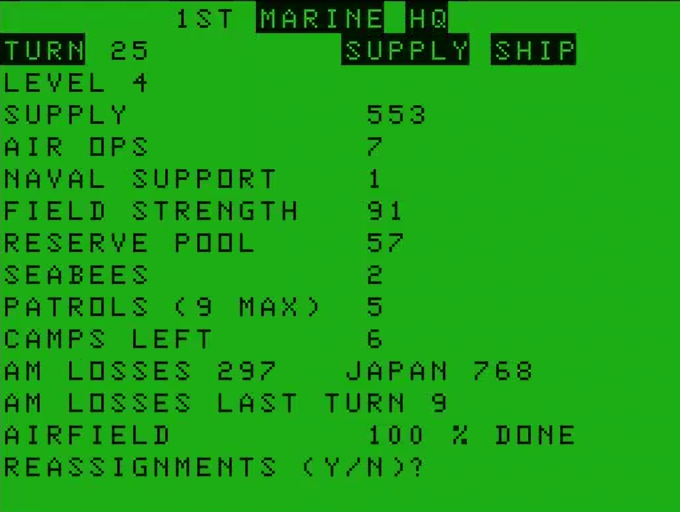
This campaign is far from over, so I prefer to end the first part of the AAR for now. I still don’t know whether I will win or lose this campaign (I am currently at turn 30 in my playthrough), but I will be able to accelerate my offensive. The clock is ticking: I have already spent half of the 45 turns I have to achieve a decisive victory, so it is a race against time in addition to a war against the Japanese. I just hope that the latter have not received the same kind of reinforcements as I did.
Guadalcanal has been an unexpected gem so far: tense, rich with difficult arbitrages to make and with a rollercoaster of emotions. One turn I am confident I have the situation well under my control and the 5 following turns I am teetering on the brink of disaster. This back-and-forth dynamic has kept the experience excellent so far, and I hope that it remains so until the end of the game.